Marc A. Pitman's Blog, page 43
July 30, 2013
July 18, 2013
Amazon is giving away my book for free today
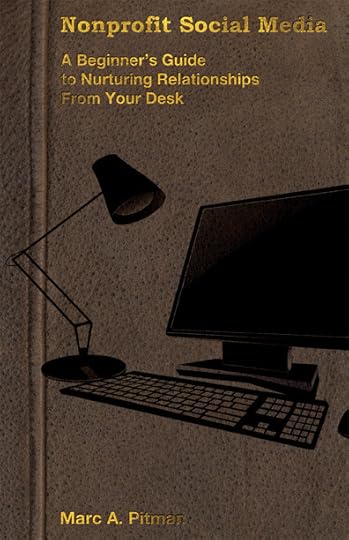 Amazon is promoting my newest book Nonprofit Social Media: A beginner’s guide to building donor relationships from your desk.
Amazon is promoting my newest book Nonprofit Social Media: A beginner’s guide to building donor relationships from your desk.
On Thursday, July 18, Amazon is giving the Kindle version away for free. Just go to http://amzn.to/13jVxup to see if they’ve set it up for free.
This book is not written for techies or geeks. This is written for normal people working in and around nonprofits.
I wrote this book because I am always getting questions about how to use Facebook, Twitter, and Google+ to market and fundraise for nonprofits. One time, a friends bought me lunch to hear me talk about YouTube. YouTube! I knew about YouTube but I don’t use it as much as others. Well, I talked straight for close to 90-minutes with technical tips and broader strategy ideas for her to use.
To help you get an idea of what’s in the book, here’s the Table of Contents:
Too often, I find nonprofit people eager to jump into Twitter or Facebook without having a decent website or an email list to attract people to. This book is based on my 14 years of experience in blogging and online marketing, including being an early adopter of many social media platforms.
This book isn’t for people who “get” social media. This book is specifically for beginners. Even though I’m a geek who writes blog posts in HTML, I’ve worked hard to keep it understandable for new people.
This book is perfect for nonprofit volunteers and staff looking to get a firm foundation in their online presence, looking to grow their database and fundraising, and interested in doing it inexpensively and without being dependent on a support team or outsourced designer. I knew I studied this stuff, but I didn’t realize how much of the things I knew that others didn’t.
I’ve also taught courses on internet marketing for business and for fundraising at colleges and graduate schools. In fact, this book was written to be the textbook for my class on “Using Social Media for Nonprofits” at the University of Southern Maine last April.
The content is good. If you’re a beginner.
To help you know what’s inside, here is the table of contents:
Introduction
Chapter 1 Why Social Media?
Chapter 2 What is Social Media?
Chapter 3 Creating a Solid Strategy & Measuring ROI
Chapter 4 Finding Your Target Audience
Chapter 5 SEO For Your Nonprofit
Chapter 6 Your Own Website
Chapter 7 Blogging
Chapter 8 Email
Chapter 9 Google and Google+
Chapter 10 Facebook
Chapter 11 Twitter
Chapter 12 YouTube
Chapter 13 LinkedIn
Chapter 14 Seven More Social Media Sites to Check Out
FourSquare
Vimeo
Flickr
MeetUp
Ning
GoodReads
Chapter 15 Some Final Thoughts on Staying Sane
The book is free today, July 18
Check it out at http://amzn.to/13jVxup!
(c) The Fundraising Coach, LLC
Get 100 donors in the next 12 weeks? Learn how: 100 Donors in 90 Days!
Other Possibly Related posts:
Book Review: Guerrilla Market for Nonprofits
“Ask Without Fear!” hits #46 on Amazon’s nonprofit list






July 17, 2013
Upcoming speaking engagements & fundraising training
I regularly get asked “Are you coming to my area?”
Most of my fundraising training and speaking is currently done for nonprofits that bring me in to speak to their boards and teams. I also get to speak and keynote at conferences. Here are the upcoming conferences I’m speaking at.
I often have extra time while I’m there. If you want to explore hiring me to train your team or board fill out the form here:
https://qc125.infusionsoft.com/app/form/training
Upcoming fundraising seminars
Oklahoma – August 2013
 The Oklahoma Center for Nonprofits is bringing me in as part of their “National Speakers Series.” I’ll be giving two 4-hour Ask Without Fear! trainings, one in Oklahoma City, one in Tulsa.
The Oklahoma Center for Nonprofits is bringing me in as part of their “National Speakers Series.” I’ll be giving two 4-hour Ask Without Fear! trainings, one in Oklahoma City, one in Tulsa.
Oklahoma City, Wednesday, August 14: National Speakers Series: Ask Without Fear!
Register at http://www.oklahomacenterfornonprofits.org/Training/TrainingCalendar/tabid/76/ModuleID/464/ItemID/686/mctl/EventDetails/Default.aspx
Tulsa, Thursday, August 15: National Speakers Series: Ask Without Fear!
Register at:
http://www.oklahomacenterfornonprofits.org/Training/TrainingCalendar/tabid/76/ModuleID/464/ItemID/687/mctl/EventDetails/Default.aspx
Grapevine, Texas – September 2013
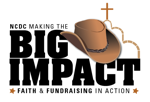 I’ll be at NCDC (the National Catholic Development Conference) at the Gaylord resort just outside of Dallas.
I’ll be at NCDC (the National Catholic Development Conference) at the Gaylord resort just outside of Dallas.
Wednesday, September 11: I’ll be representing Graham-Pelton Consulting by giving a 3-hour pre-conference session called “FaceTwitLink? Twitteredin? TheLinkedBook?: An Introduction to Social Media For Fundraising.” Get the details on the NCDC conference website.
Friday, September 13: I’ll be giving a session called The Creation and Implementation of a Gift Policy and Marketing Planned Giving. You can get the details for this session on the NCDC conference website.
Washington, DC – September 2013
 On Sunday, September 30, I’ll be giving a “Who’s Telling Your Story? pre-conference session at BBCon in Washington, DC. Get the details at http://www.bbconference.com/pre-conference-workshops/. This conference is at a Gaylord Resort too. Hhmm. Could be a theme!
On Sunday, September 30, I’ll be giving a “Who’s Telling Your Story? pre-conference session at BBCon in Washington, DC. Get the details at http://www.bbconference.com/pre-conference-workshops/. This conference is at a Gaylord Resort too. Hhmm. Could be a theme!
Austin, TX – October 2013
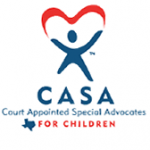 Texas CASA is bringing me in to give both a Who’s Telling Your Story? seminar and two “Ask Without Fear!” sessions at their annual conference outside of Austin on October 25 & 26. The details are being worked out by you can learn more about the conference at http://www.texascasaconference.org/.
Texas CASA is bringing me in to give both a Who’s Telling Your Story? seminar and two “Ask Without Fear!” sessions at their annual conference outside of Austin on October 25 & 26. The details are being worked out by you can learn more about the conference at http://www.texascasaconference.org/.
Want fundraising training in your area?
I love doing these trainings. If you’d like me to speak to your team around these conferences, or if you’d like me to come to you, let me know by filling out this form: https://qc125.infusionsoft.com/app/form/training
(c) The Fundraising Coach, LLC
Get 100 donors in the next 12 weeks? Learn how: 100 Donors in 90 Days!
Other Possibly Related posts:
Upcoming Fundraising Coach training events in Nebraska & San Antonio
Marc’s Speaking
EXTENDED THROUGH GIVING TUESDAY: Amazing Cyber-Monday Offer on Fundraising Training Tools






July 16, 2013
7 steps to setting up a major gift solicitation appointment
 One of the most common questions my coaching clients ask me is how to set up a solicitation appointment. The very thought of picking up the phone freezes them with fear. Their minds are flooded with worrying questions like: What will they say? How will the prospect respond? What if they mess up?
One of the most common questions my coaching clients ask me is how to set up a solicitation appointment. The very thought of picking up the phone freezes them with fear. Their minds are flooded with worrying questions like: What will they say? How will the prospect respond? What if they mess up?
Setting up a major gift solicitation appointment
Here are the tips I coach my clients through.
Get your materials together
It’s best to make 5 – 10 calls at one time. Even 15 if you can.
It takes a lot of effort to make the first phone call. It takes almost as much effort to make the second call. But by the third or fourth call, you start getting into a rhythm. You are able to test phrasing and play with intonation.
So make sure you have what you need to make those calls. Here’s what I suggest:
A list of the major gift prospects you want to call
It’s great if you’re able to access their database records. That way you can see if anyone else from your organization has tried contacting them. Or if they just sent in a gift. But sometimes a list of names and phone numbers on a piece of paper is better for helping you get the calls done. Having access to too much information can be distracting.
An index card with 3 things you’ll say
It’s awkward to be in a call and forget what you wanted to say, only to remember it after you hang up the phone! So write down 2-3 things you want to accomplish in the call. Since the sole purpose of this call is to set up an appointment, these three things might be a good start:
OK time?
I rarely ask if it’s a “good” time. I don’t need a good time. I just need 30-60 seconds of their attention to be able to get on their calendar. But with the advent of cell phones, you never know what people will be doing when you catch them. So I typically start out with, “Hi this is Marc from [the name of the nonprofit]. Am I catching you at an ok time?”
Set appointment
This is the main goal of the call, but it’s easy to talk yourself out of it. Make sure it’s one of the bullets on your index card.
Get off phone
You only want to set an appointment. You don’t want to visit about family or work or the weather. You want to set an appointment and get off the phone. If you do this well, you’ll set the right tone for the appointment itself. People will know you’re not going to waste their time.
A phone
Seriously. Whether you’re using a landline, a cell phone, or VOIP, make sure it’s working and the batteries are charged! While you’re at it, it can helpful to clear a section of your desk. And it’s probably best if you’re not feeding a baby like the father in the picture here.
Warning: Don’t waste alot of time “getting your materials together.” Gather materials doesn’t raise any money. Solicitation appointments do. It’s far more important to get into action than it is to be perfectly prepared.
Smile
Smile before you dial. Your phone call will give clues to the prospect about how your visit will be. So sound as interesting and appropriately enthusiastic as possible.
Studies have consistently shown people can “hear” if you’re smiling. If you’ve ever managed a phonathon, think about the tone in the voice of a caller who’s intentionally smiling and one who isn’t. The non-smiler sounds more like Eeyore than like an interesting human being.
Let your prospect know you’re an interesting human being!
Bonus tip: Standing up also helps your voice be more animated and energetic.
Psych yourself UP not OUT
Self-talk can kill your phone effectiveness. Most of us worry that we’ll be catching people at the wrong time. Or that we’ll be bugging people.
Listen: we’re calling adults. So let’s treat them like adults! If we’re calling them at a bad time, they can choose to let us go to voice mail!
Moreover, we might just be catching them at a good time. Even at an amazingly good time. So as you’re remembering to smile, remind yourself that you are offering people a great opportunity. That you could well be catching them at the right time. That they may have been meaning to call your nonprofit and you’re making it easier for them.
Any of you who have done alot of these calls know these can be just as true as the others. Phone calls are hard enough on their own. Don’t make them any more difficult with your negative self-talk.
Dial the number
Seriously. Don’t chicken out and opt for sending an email. Dial the number.
If a person answers
When you dial, one of two things will happen: the phone call will get answered or it won’t.
If it gets answered, you’re off to the races:
Hi is [prospect's name] there? [wait for answer]
Wonderful. This is [your name] calling from [your nonprofit]. Am I catching you at an ok time?
Well, [donor name] exciting things are happening here at [your nonprofit]. I’d love to get together with you for 15-20 minutes to talk to you about our [fund, project, program opportunities]. Would your schedule permit us to get together Tuesday afternoon or next Monday?
You’ll notice a few things in this script:
An “ok time”
First, as I mentioned before, I ask if I’m catching them at an “ok” time. If you ask them if it’s a good time, you might get them thinking about all the reasons why it’s not a good time. Why do that to yourself? If they answered the phone, most likely it is an “ok” time. So ask them that instead. The best part? If it isn’t an “ok” time, you can still ask them for the appointment. You’ll be respecting their need to get off the call by getting to the point of your call–setting up an appointment.
Let them know it’s about an ask
It’s far too easy to get to a solicitation and then chicken out. You try lying to yourself, saying things like “The timing wasn’t right.” But in reality you just chickened out.
To prevent that, let the prospect know you want to talk about something specific. Don’t make the wording so specific that they’ll get into the ask on the phone. You don’t want that at all. So let them know you’d like to talk to them about “the annual fund” or “the project” or “camperships.”
Do this, and even if you chicken out at the appointment, nine times out of ten you’ll find the prospect say, “Now what was it you wanted to talk about?” Boom. Before you know it, your solicitation is back on track.
“Schedule permits”
This is at odds with any sales training you’ll get. Those trainings will tell you to not give the prospect any “outs.” Put them on the spot and make them make a decision.
But I’ve scheduled a lot more appointments by letting the prospect’s schedule be the bad guy. Rather than making it a decision if they want to talk, I assume they do. If it doesn’t work out, it’s not because they don’t want to, it’s because their calendar won’t let them. Right now. If they use this out, I always ask, “When would be a good time to check back with you?” or “That’s too bad. May I check back with you in a couple weeks [or "months" depending on the situation]?
If a person doesn’t answer
Many of you will breath a sigh of relief. Avoid letting that sigh come during the voice mail recording! When you leave a message, use a similar script as the one above. And promise to call them back in a couple days.
Some trainers recommend not leaving a message until after the third attempt. I’ll leave that up to you. In an age of “caller id,” I find myself preferring to leave a message on the first call.
When you call them back, be sure to use a phrase like, “Hi [donor name]. This is [your name] calling back as I promised…” This sets up the expectation that you are a person of your word. You keep your promises.
Get off the phone
Don’t dilly-dally. Once you’ve agreed on a time, thank them courteously and hang up. They have things to do and you have more calls to make.
What if they want to get into the ask on the phone? What if they say something like, “C’mon. I know you’re going to ask me for money. How much is it this year?” Look back at your index card. You’ll be reminded that the goal of this call is to set up an appointment. You can try phrases like:
“I’d really like to show you [this video/a rendition/something]. Would next week be better for you?”
“This project is just too important to talk about over the phone. Let’s find a time when you and [his/her spouse] can get together.”
“Ha! I love your candor! If I thought I could do our cause justice over the phone, I would. But I’d much prefer meeting together. Is evening better than during the day?”
The one exception to this rule is if you’re going to ask them to give what they gave last year. Then you might be able to chuckle and say, “Well thanks, [donor name]. I wanted you to see how grateful we are for your support. I was going to ask you to consider giving that gift again this year.”
Only use that in select circumstances where you know the prospect. And be ready to take down a credit card number!
That’s all you need to set up a major gift appointment!
Those 7 steps will get you in the door. These are the steps I use on my own fundraising calls and I teach to my one-on-one coaching clients.
What would you add?
Have you tried steps like this? Did they work? Or do you have other strategies you’ve found to be effective? Let us know below in the comments!
(c) The Fundraising Coach, LLC
Get 100 donors in the next 12 weeks? Learn how: 100 Donors in 90 Days!
Other Possibly Related posts:
3 strategic steps for December fundraising
Fundraising Secret #79: Make Your Gift First
Gift Range Calculator






July 12, 2013
[Guest Post] How To Use Google Trends
Today it’s my privilege to introduce you to Andy Crestodina. Andy is the Strategic Director of Orbit Media, a web design company in Chicago. The author of the incredibly helpful SEO book Content Chemistry, he’s amazing when it comes to helping your website receive exactly the type of traffic you want. I’ve invited him to share about a tool I’d never heard of before: Google Trends. You’ll easily see how this can be used for your nonprofit’s website and even regular blog posts! You can find Andy on Google+ and on Twitter @crestodina.

How To Use Google Trends
Ranking starts with research. If you want to rank in search engines, you need to be deliberate about what phrases you target. That means keyword research. To do this you’ll need two main tools. These tools are both easy to use.
Google Keyword Tool*
Suggests many phrases and lists specific monthly estimates of how many people are searching for the phrase (aka “search volume”) in the US and around the world.
Google Trends
Shows relative trending of search volume of phrases over time. Best when used to compare several phrases. It also shows more specific regional interest.

*Note: Google has recently announced that this version of this tool will eventually require first logging into Google AdWords.
Since keyword research starts broad before narrowing in, the Keyword tool is a good place to start. It suggests dozens of possible phrases, giving you more ideas.
But you’re not done researching a phrase until you check trending. Here are two examples of how to use Google Trends:
Suppose you’re starting a business that helps bring traffic to company’s websites. You probably know a business or person who does this. How do they describe themselves? Do they say they do digital marketing, web marketing or content marketing?
Regardless of what they call their services, the phrases that people search for are becoming more and less popular over time. Also, people use different phrases in different places. Here’s how to see the big picture.
Visit Google Trends
Enter those three phrases
Choose the “United States” as a filter
Click “search”
Here’s what you’ll see…
Keyphrase Trending
Yellow line: “digital marketing”
Red Line: “web marketing”
Blue line: “content marketing”
Notice the changes over the last five years. The phrase “digital marketing” declined in relative popularity. In 2012, it became a less popular phrase than “web marketing.” And more recently, “content marketing” has surpassed web marketing in popularity.
Had you researched these phrases in 2011 using only the Google Keyword Tool, you may have concluded that “web marketing” is the ideal phrase, but it was actually on it’s way to becoming the least popular of the three!
What are these seasonal trends?
Look for trends indicating that a phrase consistently becomes more or less popular during different times of year. These seasonal trends are very common and often dramatic. Spotting seasonality may help you estimate monthly trends in demand for your products, services and content.
Why are so many phrases declining?
Actually, Google Trends is showing only the relative popularity of a phrase. Since there are more searches every year for ever-growing number of phrases, many phrases show a declining relative trend, even if the actual total searches for that phrase is increasing. The Google Help Docs explain this nicely with an example.
Geographic Differences
“Digital Marketing”
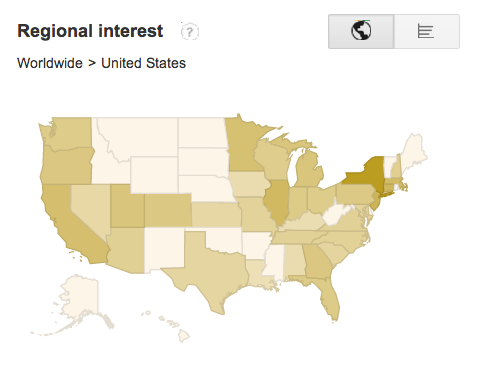
“Digital Marketing” search popularity is mostly distributed across the major markets, a bit similar to the distribution of the US population.
“Web Marketing”
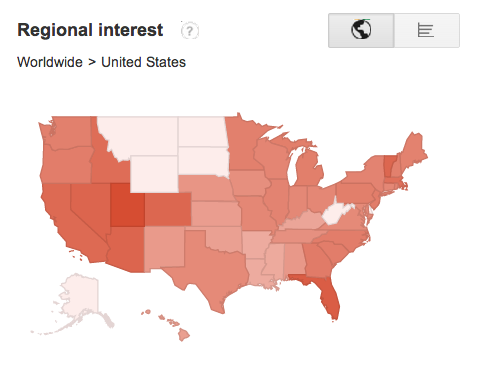
“Web Marketing” is slightly more concentrated in Utah and Florida. Interesting…
“Content Marketing”
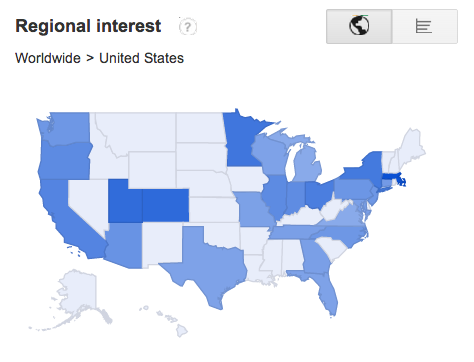
“Content Marketing” seems to be concentrated in certain areas. Do these states have something in common? They seem to be the locations of some of the bigger content marketing companies!
Takeaway
Google Trends is a way to validate your keywords, to double-check to make sure they’re not slowly dying. It’s especially useful in these cases:
Check the main target phrases of your website for up or down trending. Especially those that appear in the title tags of your home page and main service pages.
Also check geographic difference of these main phrases.
Break the tie if you’re having trouble choosing between two apparently good phrases.
If you still have questions about how to use Google Trends (or anything related to keyword research) send us a tweet or leave a comment below.
(c) The Fundraising Coach, LLC
Get 100 donors in the next 12 weeks? Learn how: 100 Donors in 90 Days!
Other Possibly Related posts:
[Guest Post] Why Donors Stop Giving
[Guest Post] Three Ways Nonprofits Can Use Promotional Products Effectively
[Guest Post] Why it’s time for YOU to say good-bye to free WiFi






July 2, 2013
5 Surprising Fundraising Books for Your Summer Reading
It’s July 2. Thousands of you are trying to pick up the pieces from the end of your fiscal year. It’s time to let your hair down and enjoy a little rest. (Yes, I know that however well you did last year, on July 1, your goal was raised. You still need a break!)
 (Was June the end of your fiscal year? Let me know when yours ends by taking the 1-question survey at: http://fundraisingcoach.com/fiscalyear/.)
(Was June the end of your fiscal year? Let me know when yours ends by taking the 1-question survey at: http://fundraisingcoach.com/fiscalyear/.)
Take time to feed your mind
When I wrote the first draft of my personal mission statement 20 years ago, I included a line: I feed my mind at least as much as I feed my stomach.
One of the best ways I’ve found to doing that is reading good books.
Here are five fundraising “must-have” books that you should consider reading this summer.
5 Book Reading List for Nonprofit Fundraising
Here are the first five books I recommend you read this summer. (These are so good that where I can, I have used Amazon or other affiliate links.)
Asking Styles
 In my own book Ask Without Fear! I included a chapter on how personality differences can influence your fundraising. Little did I know that Andrea Kihlstedt had practically made a science of personal styles and fundraising. Fortunately, she’s distilled it all into a book complete with recipe-like to do lists guiding each type through setting up the ask and conducting themselves during the ask. This book is amazing. It’s so good, I’ve started using it with all my coaching clients.
In my own book Ask Without Fear! I included a chapter on how personality differences can influence your fundraising. Little did I know that Andrea Kihlstedt had practically made a science of personal styles and fundraising. Fortunately, she’s distilled it all into a book complete with recipe-like to do lists guiding each type through setting up the ask and conducting themselves during the ask. This book is amazing. It’s so good, I’ve started using it with all my coaching clients.
You can get Asking Styles from their site at www.AskingMatters.com. (You can take a free Asking Style assessment at www.AskingStyleProfile.com/.)
Go for No!
July 1, 2013
2 of the least common words fundraisers hear
Happy New (Fiscal) Year!
July 1st is the start of the new fiscal year for 100′s of 1,000′s of nonprofits. You’ve just closed the books but now you have an even higher bar to reach.
Here’s a quick video with a sincere message to all who fundraise: thank you.
Don’t see the video here? It’s up on YouTube at http://youtu.be/_aBpY7WgHfQ
When does your fiscal year end?
Is June the end of your fiscal year? Let us know at:
http:fundraisingcoach.com/fiscalyear/
(c) The Fundraising Coach, LLC
Get 100 donors in the next 12 weeks? Learn how: 100 Donors in 90 Days!
Other Possibly Related posts:
A thank you to nonprofit fundraisers
Valentine’s Day for fundraisers – showing yourself the love
3 Common Questions about 100 Donors in 90 Days






June 23, 2013
[Guest Post] The money making secret of effective donor newsletters
I’m a huge fan of Tom Ahern. The very first time I heard him speak, I learned tactics that transformed my fundraising writing and made it much more effective. He even convinced me donor newsletters could be actual fundraising tools! So when I saw this blog post in his email a while back, I asked him to let me post it for you too. You can see him talk about effective donor newsletters by watching this Movie Monday. He’s even released a brand new series of DVDs that are amazing. Sign up to get his emails at http://aherncomm.com/. Tom can be reached on Twitter @thattomahern

The charity newsletter: Friend or foe? Getting past your unprofitable fears
by Tom Ahern
Let’s tear down some common barriers …
the ones that stand between your organization …
and creation of a newsletter that improves retention …
thereby boosting the lifetime value of your donor list.
Because when you get right down to it? Newsletters: they’re all about the money…eventually.
The rogue’s gallery:
We did a newsletter before. It didn’t work for us.
This conclusion implies that some organizations are just not “good newsletter material,” when in fact most newsletters are built to fail, not to succeed. Learn to do your donor newsletter the right way, and it will work.
I’m a fundraiser, not a journalist.
You don’t have to be a great writer to create a great charity newsletter. Paradoxically, your newsletter isn’t really about getting people to read your articles. Your newsletter is actually about delivering joy to your donors repeatedly. You can swiftly accomplish that profitable feat in a handful of headlines. So mothball your “writer’s block” anxieties. You don’t need to write exquisite articles. You will need to learn how to write a competent headline. But that’s about it. And it’s an easily acquired skill.
I have other priorities.
I hear you: my to-do list always outpaces my workday, too. So the question becomes (especially in a small or one-person fundraising shop): Is a newsletter worth making time for? Should it be a top priority or an also-ran? Well, that depends. If your organization believes (as I do, because I’ve seen the proof repeatedly) that donor-centricity is the surest route to increased income and retention, then you need a tool to help you nurture relationships with all your donors – not just those lucky few whom you can reach one on one. The proper tool for mass cultivation is the donor newsletter.
I don’t have any stories.
“There are eight million stories in the Naked City. This has been one of them,” the narrator intoned at the close of each episode. Naked City was one of the first TV crime dramas, set in New York City. They knew they’d never run out of stories. Nor will you. At Health Care for the Homeless (Baltimore), director of development Keiren Havens makes a practice of regularly trolling the front-line staff for true-life stories. She’s also educated the social workers there about the financial good it does the agency to have great stories to tell. As a result, social workers have become eager “story gatherers.” You’re not asking them to write up polished 500-word summaries, either. You’re asking them to send you 50 rough words in an email.
I’m not a designer.
You don’t have to be. Even the most graphically challenged can send out to donors a simple (yet soul-satisfying) “newsy-letter” created in Word. Trust me: if you can write any kind of letter (to your son at camp?), then you can create a successful newsy-letter. Fancy-pants design is NOT what makes a donor newsletter work.
I can’t justify it to my boss.
Look: the financial hurdle for newsletters is really low. If you break even – if you bring in enough gifts to cover your postage and printing – then you’re already beating the odds. Donor newsletters aren’t about current income, after all (though they can produce miracles in that department). Donor newsletters are about retaining donors for the long haul. Which is just smart business.
This originally appeared in Tom’s email newsletter.
Tom’s brand new donor communication DVD is on sale until this coming Friday. Get it at –> Tom Ahern’s Donor-Centric Communication DVDs.
(c) The Fundraising Coach, LLC
Get 100 donors in the next 12 weeks? Learn how: 100 Donors in 90 Days!
Other Possibly Related posts:
[Guest Post] 7 ways to thank a donor
[Guest Post] Why Donors Stop Giving
[Guest Post] Helping board members maximize fundraising effort






June 21, 2013
WGN’s Bill Leff Show: Keeping donors safe, and a little Stanley Cup smack talk

Last Friday, I got to be interviewed by WGN Radio’s Bill Leff
We talked about the Tampa Bay report on the 50 Worst Charities and how donors can protect themselves.
We also engaged in a little friendly Stanley Cup smack talk. 
You can hear the 10 minute interview on the WGN Radio site or listen to it here:
The transcript of Bill Leff interviewing Fundraising Coach Marc A. Pitman on WGN Radio, June 14, 2013
In case you’d prefer to read the interview, here’s the transcript
Bill Leff: Let’s now talk to Marc Pitman. Marc is The Fundraiser Coach. Not “a” fundraiser coach, “the” fundraiser coach. Let’s talk about charitable donations.
How are you Marc? Nice to talk to you.
Marc: You know, I was doing really well until I got on the air and heard all this Blackhawk talk.
Bill: Why do you say that?
Marc: As a Boston guy – about if Crawford had been pulled [in Game 1]? That might have been a good thing. That might’ve been a benefit.
Bill: You would’ve been okay with that? Are you a Bruins fan?
Marc: Well yeah. I’m a situational fan, because I grew up in Red Sox nation, so I know that I just cheer for the Boston teams whether they’re doing badly or not, and they’ll probably let us down. But the Bruins, I was really gutting it out all three overtimes the other night.
Bill: You know what: I said this to Dave, who you were just hearing a second ago. I said this to Dave yesterday, if there was any doubt about this team among Blackhawk fans, is this the best team we’re going to play in the Stanley Cup Finals? All those concerns were quickly melting away because the Bruins brought their game; they looked fantastic.
Marc: It was a fun game to watch. My wife is saying this all the time – we don’t normally watch sports much, but she said, “It was just a gorgeous game” to watch.
Bill: It was.
Marc: People really – they both brought their game and you can see why they both made it to the Stanley Cup Finals.
Bill: Yup. And because of the hour time difference, I wish you had called me up Marc and told me how it ended, because you got to find out an hour before me didn’t you? I’m not good with time.
Marc: Actually, a full confession: I went to bed. Hey, we had that power play going into the third overtime….
Bill: I know.
Marc: How could we blow that?
Bill: I know. I know. The five on three, I know.
All right, let us, if you wouldn’t mind talk about the charitable donations, which is why we brought you here. Here’s a concern, and I know you hear this all the time, Marc. People say, “I want to give money.”
Something terrible has happened somewhere in the country or somewhere in the world, and “I want so badly to help. I want to send some money, but my main concern is the right amount of money won’t go to that charity.” You hear this all the time. What’s going on with that?
Marc: Isn’t it awful?
Bill: Yeah.
Marc: Ever since the beginning of, I guess humanity; there have been people that want to take advantage of our instincts to do good and toward it. I think part of what inspired this call – did you see that list from Tampa?
Bill: I did.
Marc: The Nation’s 50 Worst Charities.
Bill: Yup.
Marc: It just kills people like me because you know that the people that are raising – I was just looking at the financials for The Kid’s Networks, one of the scams – seventeen million dollars and you know that they’re preying on your grandmother and your great-aunt, who’s just sitting at home trying to do the right thing and sending in their checks because they keep getting letters in the mail. It’s awful.
Bill: I’ve heard people with saltier tongues than me say that there’s a special place in hell reserved for people that would do this. That would prey on people, because you’re really doing two different people a disservice. You’re stealing money from people who think they’re giving to a good cause, and you’re also kind of besmirching the name of whoever has just gone through something terrible.
Marc: Totally true, especially when you see disaster reliefs. It’s amazing to me how they name these organizations. The creativity that we’re funneled for good would be powerful, because they’ll take any disaster relief and then they’ll create their own little charity. Even in Haiti, Wyclef Jean seemed to maybe do that because his charity doesn’t seem to have given out much money.
It’s almost like they’ll the Red Cross, which is a wonderful disaster relief organization and they’ll call some of themselves the Red Crutch. Then they’ll set up a boiler room and just start raking in money. But there are ways that donors can help avoid that.
I guess the good news is, if there’s a silver lining with these bad apples, is there’s a few – especially in our internet age, there’s a few things that donors can do to help avoid getting sucked into scams, and that’s what excites me.
Bill: Let’s do this, Marc, if you wouldn’t mind in a moment we’ll come back and talk about some of those ways. Because really, if you have it in your heart to give to a charity, the last thing you want to worry about is the right of money going, if at all, going to the charity that it is intended to go to.
Marc Pitman is joining us, the Fundraiser Coach. We’ll talk more in just a little bit. This is WGN.
[Commercial]
Bill: It is Bill Leff with you on WGN, Jonathan Brammer is going to make his way in, in about 10 minutes. My guest is Marc Pitman, the Fundraising Coach. His website is www.fundraisingcoach.com. His book is Ask Without Fear. We’re talking about how you know if your charitable donation is going to the charity in which it’s intended.
A little while ago Marc, you brought up an article; a really, really nice expose that was written in the Tampa Bay Times about just this. They say in there, they’re talking about some of the worse charities in America. They tell the story of the Kid’s Wish Network, which over the years has raised $110 million dollars, and of that $100 million, they have given $4.8 million to charities and the rest they have kept. This is roughly three cents on the dollar. How do they get away with this?
Marc: Well I think it’s because of a couple of things, and one of them is in the article, that the regulators that cite them; there’s no-teeth for the regulations, so when they’re fined, they’re only fined a few hundred dollars.
Bill: So they could certainly afford it.
Marc: It’s a great “investment.”
Bill: Yeah, it’s a great investment.
Marc: They still get to keep 10’s of millions of dollars.
Bill: Don’t you have to apply to get some sort of a license to be a recognized charity. And how is somebody giving them a license with these sort of results?
Marc: Well, I think part of what we need to remember is these are outliers. I’m not at all, at all advocating what they do but we have over a million and a half charities in the United States alone. Over the last eight years there has been 700 or 800 new 501(c)3 charities approved by the IRS.
Another statistic: with 10,000 boomers reaching retirement age every day, there’s more and more people looking at “what’s the second half going to be like? What am I going to do with the rest of my life? What’s my meaning, what’s my legacy?” So there’s going to be more and more charities. I don’t even know what the decimal point of $1.5 million versus 50 is, but these are the really bad extremes.
Having said that, I think part of it is the regulation and the oversight. The states are swamped, and I think donors aren’t necessarily doing the due diligence that they should. One of the first things I tell donors is “don’t give money over the phone.”
Bill: As a rule, if somebody calls you up and says, “Look, there’s been a disaster and we’re putting together a fund to help the families.” If it’s over the phone you say, “Stay away.”
Marc: It seems almost like having those e-mails from your long lost Nigerian prince relative. Yes, I would say stay away. Send me something in the mail, or go to a reputable site. There’s a lot of good disaster relief organizations out there.
In fact, I was just learning with the Chronicle of Philanthropy, I think was reporting with the last disaster with the tornado area – or it was Tess Vigeland and NPR was saying gift cards are the way to go.
If you can mail gift cards to organizations, that’s easier to get into peoples’ hands than cash. We have a tendency, as Americans to think clothes and food, which is sometimes the last thing people need. They need diapers, they don’t need food.
So gift cards allow the organizations to actually use it for donors, so you know that it’s going to go over into the victim’s hands. It also gives you some sense of control over that.
Bill: It’s funny you say that about food because I think most of us would just have a natural inclination to think whenever something bad goes on, “I’ve got to send them food because the grocery stores have been decimated. I’m going to send some food and it’s going to help people.” But I’ve seen announcements several times of late where they say, “Please no more food. We can’t take food.” Or toys, I see also. “Don’t send kids anymore toys, we’re filled up with those.”
Marc: Doctors Without Borders is one of the organizations that, as a fundraising guy I totally admire. Because in the Haiti they ended up – remember them saying, “Please stop sending us money.”
Bill: Yeah, how about that. Stop sending us money. How does that happen?
Marc: Well because when you designate a gift to a disaster relief, technically it’s supposed to stay in that fund. You put that string attached to it so they can’t use it for anything else but those reliefs, and they knew they’re planning enough to be able to say, “Okay, there’s no way we can take more for this. If you’d like to give to our other stuff we’re doing around the world we’d love that, but please stop.”
I think that was one of the best pieces of charity-related media that could ever come because forever, I’ll be talking about how they were saying, “Please don’t send us any money.”
But what donors can do – have you heard of www.guidestar.org?
Bill: I have not. What is Guidestar.org?
Marc: All the charities that are past the IRS scrutiny of becoming a 501c3, even though we’ve called that into question already this morning, have to report on their finances every year. Guidestar.org collects all of those. They’re called the 990 that the charity puts out. It shows what their fundraising expenses are, it shows what their program expenses are, it shows what the top salaries of their top employees are, or the top five officers or employees.
There’s a ton of information on the web. I just pulled up the Kid’s Wish Network; I think that’s the one in Florida.
Bill: It is.
Marc: Yeah, it’s all here. It’s stuff here. And it’s not necessarily the easiest to read, but even on the first page, you can see that they raised a ton of money and they spend over 50% of that in fundraising expenses, and so I’m not a big advocate of seeing a hard and fast overhead percentage, but that should be a red flag. If that much money is going out, you need to look a little further.
Is it systemic? Are they spending a lot of money on outside things that aren’t cause-related, or is it strategic? If it’s strategic, just like a business, non-profits need to grow. So there are times that they’re going to invest more heavily in marketing and in fundraising so that they have the lifelong donors that they’re going to establish from that.
Bill: Marc, I know that there’s always going to be overhead costs for anything like this, but is there some sort of a safe standard? Is it 5 percent, is it 10 percent? What should the overhead costs be for any given charity? Is it a certain number?
Marc: Yeah. This is where I don’t like those rating organizations like charity watchdog groups that say, “Well overhead should never be more than 35% or 10% or whatever,” because it changes. It’s harder, especially in cash drought times, like now where we have the talent that’s coming into the non-profit space is extremely sophisticated and can command a good salary, and organizations need that kind of a skill level. So it’s a very complicated one.
I’ve heard a lot of people say 35% and I’ve heard other things. But then that forces charities into this weird accounting thing of, “Well that’s not overhead. Those employees over there aren’t overhead because they’re actually doing mission, so we’re going to count them as program cost, not as administrative costs.” It somewhat becomes an accounting shell game then.
Bill: It’s deceiving. It is.
Marc: Yeah, it’s sort of like sick days. Are you really sick or is it a mental health day? How do you account for those sick days that you take when you’re an employee?
Bill: You can’t. You can’t.
That is Marc Pitman, The Fundraising Coach. His website is www.fundraisingcoach.com. His book is Ask Without Fear. His hockey team is the Boston Bruins. Marc, I hope your team comes in a very close second place. Is that fair?
Marc: And I hope you’re wrong.
Bill: All right, we’ll see what happens. Marc, thanks very much. I hope you have a great Father’s Day. Thanks for joining us.
Marc: Thank you!
[End]
(c) The Fundraising Coach, LLC
Get 100 donors in the next 12 weeks? Learn how: 100 Donors in 90 Days!
Other Possibly Related posts:
The Ask Without Fear! Radio Talk Show
Developing Your Personal Giving Strategy: A Donor’s Guide to Safe Giving
“Ask Without Fear!” is selling as well as Bill Clinton’s “Giving”












